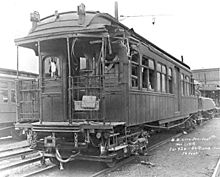Malbone Street subway accident
In the railway accident of Malbone Street ( English : Malbone Street Wreck or Brighton Beach Line Accident ), today: Metro Station Prospect Park the New York subway in Flatbush , Brooklyn , derailed due to excessive speed on 1 November 1918 train of Brooklyn Rapid Transit Company (BRT) coming from Franklin Avenue in a tight arc. At least 93 people were killed and over 100 others were injured.
Starting position
The entrance to the then Malbone Street station was via an S-curve with extremely tight curve radii , which had only been put into operation a few weeks earlier. A speed limit of 10 km / h (6 mph) was provided at this point.
The trains used at that time had wooden bodies. The crashed train consisted of 5 cars , of which the first, fourth and fifth were railcars , and the cars were two and three sidecars . The motor cars were about twice as heavy as the sidecars and their center of gravity was considerably lower. Normally two sidecars were never coupled to each other, but always placed between two railcars. This gave them the stability they needed.
On the day of the accident, the BRT was the union Brotherhood of Locomotive Engineers (BLE), a part of the train drivers represented, on strike . As a result, there was a shortage of locomotive drivers and the train was driven by an inexperienced driver. The train was occupied with about 900 passengers .
the accident
The locomotive driver usually worked in personnel planning , had only gained some experience in shunting empty trains a year beforehand , had no knowledge of the route and only received a two-hour briefing from a driving instructor prior to his assignment. 60 hours of training were common. The train involved in the accident was the first scheduled train it ever drove.
In the train, contrary to the rule, two sidecars, the second and third, ran directly behind one another. Their center of gravity was higher than that of a railcar, especially when the weight was increased by numerous travelers .
Instead of the prescribed 10 km / h, the train at 18 o'clock 22 at a speed estimated at least 50 km / h approaching the station . The train was carried out of the curve. First, the bogie of the leading railcar derailed and the two following sidecars tore off the track. The second and third cars were thrown against the outer wall of the tunnel and smashed. The following car suffered less damage, the last one remained almost intact.
consequences
With 93 dead and over 100 injured, this was the second worst train accident in US railroad history and the worst in the history of the New York subway. The engine driver was unharmed. He and representatives of the operating company BRT were charged with manslaughter but acquitted .
Whether the use of wagons with wooden bodies had increased the consequences of the accident remained controversial. Vehicles , some of which were made of wood, remained in use until 1969.
The reputation of the operating company BRT suffered considerably from this accident. Contrary to the facts, your bankruptcy on New Year's Eve of the same year is linked to this calamity.
Because of the accident, Malbone Street was renamed Empire Boulevard .
useful information
The tunnel remained in operation for tourist traffic for another 40 years, but no longer for the main line after 1920. Today the tunnel belongs to the Franklin Avenue Shuttle and is occasionally used for unscheduled train movements. In 1974 there was an accident at the same place in which a train derailed and hit the tunnel wall. But there were no injuries.
See also
literature
- Brian Cudahy: The Malbone Street Wreck . New York. Fordham University Press 1999.
- Brooklyn Daily Eagle v. October 27, 1919, p. 10.
- Paul Matus: Review of Brian Cudahy: The Malbone Street Wreck .
- David Rapp: Death in the Subway .
- Gene Sansone: New York Subways: An Illustrated History of New York City's Transit Cars . Baltimore 2004. ISBN 0-8018-7922-1 , p. 165.
- Ludwig Stockert : Railway accidents (new episode) - Another contribution to railway operations theory . Berlin 1920, no.290.
Web links
Individual evidence
- ^ Stockert: Railway accidents (NF), gives November 2, 1918 as the date of the accident.
- ↑ Stockert: Railway accidents (NF), names 85 dead and assumes around 200 injured.
- ^ Stockert: Railway accidents (NF).
- ↑ Photo of the damaged wagons after recovery.
- ^ BMT Franklin: Prospect Park
Coordinates: 40 ° 39 ′ 42.3 " N , 73 ° 57 ′ 44.1" W.

